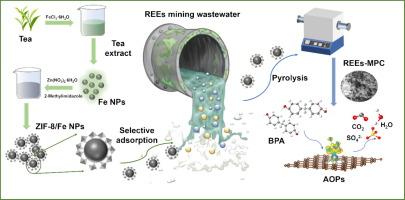One-step pyrolysis of ZIF-8 after recovering rare earth elements from mining wastewater as a functional fenton-like catalyst
IF 13.2
1区 工程技术
Q1 ENGINEERING, CHEMICAL
引用次数: 0
Abstract
The management of rare earth elements (REEs) from mining wastewater has consistently a key issue. Our previous research has demonstrated the selective adsorption of REEs in mining wastewater by ZIF-8. Herein, one-step pyrolysis of ZIF-8 after recovering REEs from mining wastewater as a high-value product was further proposed. The resulting REEs-based magnetic nanoporous carbon materials (REEs-MPC) was utilized for the activation of peroxymonosulfate (PMS) in the removal of bisphenol A (BPA). Experimental results indicate substantial BPA removal efficiencies of 74.62 %, 83.57 %, and 70.06 % with REEs-MPC synthesized at different pyrolysis temperatures (700 °C, 800 °C, and 900 °C). The detailed characterizations reveal the REEs-MPC at 800 °C was obtained (REEs-MPC/800) exhibit prominent graphitic and defective characteristics. In addition, electrochemical analysis revealed that the REEs-MPC/800 demonstrate elevated conductivity and superior capacitive current, with Tafel slopes as high as 294 mV/dec. Functional theory (DFT) calculations demonstrate that the presence of graphitic-N and REEs-N species significantly enhance PMS activation. Finally, a neural network model constructed through machine learning techniques provided a comprehensive overview of the structure–property relationship. Overall, the proposal to synthesize a high-value product using mining wastewater has been put forward. This initiative is expected to contribute to the advancement of the green economy within the rare earth mining industry.

从采矿废水中回收稀土元素后一步热解 ZIF-8 作为功能性类芬顿催化剂
采矿废水中稀土元素(REEs)的管理一直是一个关键问题。我们之前的研究证明了 ZIF-8 对采矿废水中稀土元素的选择性吸附。在此,我们进一步提出了一步热解 ZIF-8,然后从采矿废水中回收 REEs 作为高价值产品。得到的基于 REEs 的磁性纳米多孔碳材料(REEs-MPC)被用于活化过一硫酸盐(PMS)以去除双酚 A(BPA)。实验结果表明,在不同热解温度(700 ℃、800 ℃ 和 900 ℃)下合成的 REEs-MPC 对双酚 A 的去除率分别为 74.62 %、83.57 % 和 70.06 %。详细的特性分析表明,在 800 °C 下获得的 REEs-MPC (REEs-MPC/800)具有突出的石墨化和缺陷特征。此外,电化学分析表明,REEs-MPC/800 表现出较高的导电性和优异的电容电流,塔菲尔斜率高达 294 mV/dec。函数理论(DFT)计算表明,石墨-N 和 REEs-N 物种的存在显著增强了 PMS 的活化。最后,通过机器学习技术构建的神经网络模型提供了结构-性能关系的全面概述。总之,利用采矿废水合成高价值产品的建议已经提出。这一举措有望促进稀土采矿业绿色经济的发展。
本文章由计算机程序翻译,如有差异,请以英文原文为准。
求助全文
约1分钟内获得全文
求助全文
来源期刊

Chemical Engineering Journal
工程技术-工程:化工
CiteScore
21.70
自引率
9.30%
发文量
6781
审稿时长
2.4 months
期刊介绍:
The Chemical Engineering Journal is an international research journal that invites contributions of original and novel fundamental research. It aims to provide an international platform for presenting original fundamental research, interpretative reviews, and discussions on new developments in chemical engineering. The journal welcomes papers that describe novel theory and its practical application, as well as those that demonstrate the transfer of techniques from other disciplines. It also welcomes reports on carefully conducted experimental work that is soundly interpreted. The main focus of the journal is on original and rigorous research results that have broad significance. The Catalysis section within the Chemical Engineering Journal focuses specifically on Experimental and Theoretical studies in the fields of heterogeneous catalysis, molecular catalysis, and biocatalysis. These studies have industrial impact on various sectors such as chemicals, energy, materials, foods, healthcare, and environmental protection.
文献相关原料
公司名称
产品信息
麦克林
PMS
麦克林
acetonitrile
麦克林
methanol (MeOH)
麦克林
2-Methylimidazole (C4H6N2)
阿拉丁
BPA
 求助内容:
求助内容: 应助结果提醒方式:
应助结果提醒方式:


